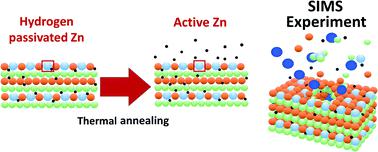当前位置:
X-MOL 学术
›
J. Anal. At. Spectrom.
›
论文详情
Our official English website, www.x-mol.net, welcomes your
feedback! (Note: you will need to create a separate account there.)
Electrically active and hydrogen passivated Zn in GaAs/AlGaAs specifically distinguished during secondary ion mass spectrometry depth profiling
Journal of Analytical Atomic Spectrometry ( IF 3.1 ) Pub Date : 2020-10-19 , DOI: 10.1039/d0ja00369g Adrianna Wójcik 1, 2, 3, 4, 5 , Walery Kolkowski 3, 6, 7 , Iwona Pasternak 3, 5, 6, 7, 8 , Włodzimierz Strupiński 3, 5, 6, 7, 8 , Sylwia Kozdra 1, 2, 3 , Paweł Piotr Michałowski 1, 2, 3
Journal of Analytical Atomic Spectrometry ( IF 3.1 ) Pub Date : 2020-10-19 , DOI: 10.1039/d0ja00369g Adrianna Wójcik 1, 2, 3, 4, 5 , Walery Kolkowski 3, 6, 7 , Iwona Pasternak 3, 5, 6, 7, 8 , Włodzimierz Strupiński 3, 5, 6, 7, 8 , Sylwia Kozdra 1, 2, 3 , Paweł Piotr Michałowski 1, 2, 3
Affiliation

|
A precise control over the depth distribution of major, minor and trace elements in a structure is crucial for practical applications of semiconductors. Thus, reliable characterization tools capable of measuring depth distribution of electrically active impurities are essential to advance currently existing growth technologies. Secondary Ion Mass Spectrometry (SIMS) is frequently used to measure depth profiles of impurity atoms; however it provides only total elemental concentration distribution. In contrast techniques capable of measuring dopant profiles typically omit information concerning electrically inactive impurities. In this work, we propose a method for obtaining quantitative profiles of both active and hydrogen-passivated (inactive) zinc in a GaAs/AlGaAs sample using Ultra Low Impact Energy SIMS (ULIE-SIMS). The key to the procedure is the ability of ULIE-SIMS to measure complex As3Zn and hydrogen signals. The zinc–arsenic signal is a marker of the active Zn profile, whereas the hydrogen signal delivers information about the hydrogen-passivated impurity profile. Annealing of the sample provides further validation of the method as the observed increase of active Zn and decrease of passivated Zn signals is associated with hydrogen escaping from the sample surface. The presented approach can potentially be used in optimization of growth processes and controlling the level of impurity activation in semiconductor materials.
中文翻译:

GaAs / AlGaAs中的电活性和氢钝化Zn在二次离子质谱深度分析过程中得到了特别的区分
精确控制结构中主要,次要和痕量元素的深度分布对于半导体的实际应用至关重要。因此,能够测量电活性杂质深度分布的可靠表征工具对于推进当前现有的增长技术至关重要。二次离子质谱法(SIMS)经常用于测量杂质原子的深度分布。但是,它仅提供总元素浓度分布。相比之下,能够测量掺杂剂分布的技术通常会省略有关电惰性杂质的信息。在这项工作中,我们提出了一种使用超低冲击能SIMS(ULIE-SIMS)获得GaAs / AlGaAs样品中活性和氢钝化(非活性)锌的定量分布图的方法。3 Zn和氢信号。锌-砷信号是活性Zn曲线的标志,而氢信号传递有关氢钝化杂质曲线的信息。样品退火为该方法提供了进一步的验证,因为观察到的活性Zn的增加和钝化Zn信号的减少与氢从样品表面逸出有关。提出的方法可以潜在地用于生长过程的优化和控制半导体材料中杂质活化的水平。
更新日期:2020-11-27
中文翻译:

GaAs / AlGaAs中的电活性和氢钝化Zn在二次离子质谱深度分析过程中得到了特别的区分
精确控制结构中主要,次要和痕量元素的深度分布对于半导体的实际应用至关重要。因此,能够测量电活性杂质深度分布的可靠表征工具对于推进当前现有的增长技术至关重要。二次离子质谱法(SIMS)经常用于测量杂质原子的深度分布。但是,它仅提供总元素浓度分布。相比之下,能够测量掺杂剂分布的技术通常会省略有关电惰性杂质的信息。在这项工作中,我们提出了一种使用超低冲击能SIMS(ULIE-SIMS)获得GaAs / AlGaAs样品中活性和氢钝化(非活性)锌的定量分布图的方法。3 Zn和氢信号。锌-砷信号是活性Zn曲线的标志,而氢信号传递有关氢钝化杂质曲线的信息。样品退火为该方法提供了进一步的验证,因为观察到的活性Zn的增加和钝化Zn信号的减少与氢从样品表面逸出有关。提出的方法可以潜在地用于生长过程的优化和控制半导体材料中杂质活化的水平。











































 京公网安备 11010802027423号
京公网安备 11010802027423号